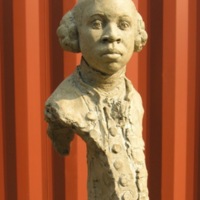
OLAUDAH EQUIANO - African, slave, author, abolitionist
This sculpture of the abolitionist Olaudah Equiano was made by London-based sculptor Christy Symington in 2006 to mark the bicentenary of the abolition of the British transatlantic slave trade, with the intent to further share Equiano's story. It was first exhibited by selection at the Society of Portrait Sculptors 'FACE 2007' annual exhibition. The sculpture portrays Olaudah Equiano’s social standing through his clothing and hairstyle which was unusual for a black man in that time. The continent of Africa is implied by the shape of the back of his shoulders arrived at by chance whilst modelling. Broken shackles and chains are sculpted down the side of the sculpture, prompting his opposition to slavery as an abolitionist and his path to freedom. The Brookes slave ship diagram and an enlarged detail of a single enslaved female figure from the diagram are found on the stem of the sculpture - a reminder that there were women and children on the ships as well as men.
Since 2007, the sculpture has featured in several other exhibitions including a solo 'OLAUDAH EQUIANO MAN AND BROTHER' at the Stephen Lawrence Centre Gallery (2015); 'Black Georgians: The Shock of the Familiar' at the Black Cultural Archives (2016); 'Revelation of the Head' at Messums Wiltshire (2018); 'Untold Stories: A Celebration of Black People in Kent' (2018); Royal Society of Sculptors Members' 'Summer Exhibition' (2018); and Salon d'Automne Paris (2019). There is a bronze edition and in 2017 a black and white duo edition (featured in exhibition 'OLAUDAH EQUIANO in BLACK and WHITE' at SPACE). The bronze sculpture is now in the permanent collections of the International Slavery Museum in Liverpool (2017), Royal Museums Greenwich (2018) and Parliament UK (2019).
Photos: Tontxi Vazquez / Sylvain Deleu © Christy Symington MRSS/DACS 2019
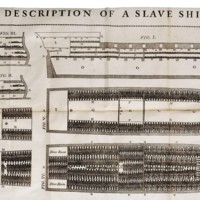
The Print that Turned the World?
The Print that Turned the World? was an exhibition at the London Print Studio, which examined the role played by printmaking in changing public attitudes towards the slave trade and influencing the abolition campaign. The exhibition looked in particular at the influence of the widely publicised print of the slave ship 'Brookes', first published in 1788; the crowded and inhumane conditions depicted had a significant impact on public opinion. The exhibition also examined the role of William Wilberforce in the abolitionist campaign, and the continuation of anti-slavery efforts in modern times. London Print Studio worked with local schoolchildren in creating the exhibition and associated artworks.
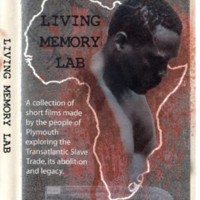
Living Memory Lab
The Living Memory Lab was a two-year project in which people from local communities of Plymouth made three-minute films on the subjects of slavery and abolition and local connections to the slave trade. A series of short training courses in basic film-making were offered as part of the project. The project was a partnership between Plymouth and District Racial Equality Council, BBC South West, the community arts agency Creative Partnerships, in collaboration with Plymouth City Museum and Art Gallery. The DVD was made freely available for use as a teaching aid and community resource.
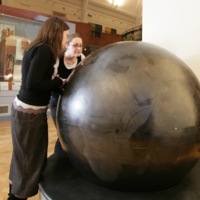
Blue Earth 1807-2007
The sculpture Blue Earth 1807-2007 by African artist Taslim Martin was permanently installed in the newly updated African Worlds Gallery at the Horniman Museum in 2007, to mark the bicentenary. The large iron globe, inscribed with the 18th century image of the slave ship Brookes, traces the routes along which enslaved Africans were transported to the New World, alongside the movement of the products of enslaved labour. The major British ports of Liverpool, London and Bristol are depicted, as well as ports in West Africa and some of the destination ports in North America, the Caribbean and South America. Visitors are encouraged to spin the globe to view slave routes across the world. In 2007-2008, the Horniman Museum also hosted 'La Bouche du Roi' by Romuald Hazoumé.
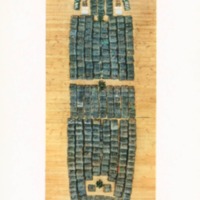
La Bouche du Roi
La Bouche du Roi was created by artist Romauld Hazoumé, who lives and work in the Republic of Benin, West Africa. The multi-media artwork is named after a place on the coast of Benin from where enslaved Africans were transported. It comprised 304 plastic petrol can 'masks', each representing a person, arranged in the shape of the woodcut of the Liverpool slave ship Brookes. The aroma of tobacco and spices are represented alongside the terrible smells of a slave ship. The artwork was accompanied by a film showing the motorcyclists who transport petrol illegally between Nigeria and the Republic of Benin. The cans and motorcyclists are metaphors for modern forms of enslavement and resistance. First exhibited at the British Museum in London, La Bouche du Roi toured to the following venues during 2007-9: Ferens Art Gallery in Hull, International Slavery Museum in Liverpool, Bristol's City Museum and Art Gallery, Laing Art Gallery in Newcastle, and the Horniman Museum in London.
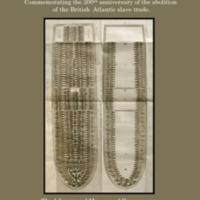
Squaring the Triangle: Freemasonry and Anti-Slavery
The exhibition at the Library and Museum of Freemasonry to mark the bicentenary arose from a project to catalogue their historical collections relating to Masonic history in the West Indies and America between 1760 and 1900. This period covers the establishment of African Lodge, the first Masonic lodge for African-Americans. Its first Master was Prince Hall, a freed slave and respected Boston resident who had fought for the British. From 1847 his name has been synonymous with Prince Hall Masonry, the first major Black Masonic organisation in the world. The library holds eleven letters written by or for Prince Hall. The exhibition and cataloguing of this correspondence enabled the library to start compiling details of early Black and Asian Freemasons in its collections. The exhibition also looked at members in the 18th and 19th century who were both slave owners and abolitionists, and the establishment of lodges in the Caribbean.

Wilberforce 2007 at Ferens Art Gallery
Hull Museums had a programme of special exhibitions at the Ferens Art Gallery commemorating Wilberforce 2007. The Abolitionist's Parlour was a new work commissioned by the Gallery. The video installation by artist Keith Piper explored the role of William Wilberforce through the writings of a fictional black woman and ex-slave. Uncomfortable Truths: The Shadow of Slave Trading on Contemporary Art, in partnership with the Victoria and Albert Museum, explored the uncomfortable relationship between art, design and slavery through the work of eleven international artists. The international audio-visual exhibition Anne Frank + You explored the thoughts and themes from Anne Frank's diary which included conflict, racism, democracy and freedom. Mind Forg'd Manacles: William Blake and Slavery was an exhibition of rare watercolours and prints by William Blake, on loan from the British Museum. Ferens Art Gallery also hosted La Bouche du Roi by Romuald Hazoume, a multi-media exhibition based around the Brookes slave ship.
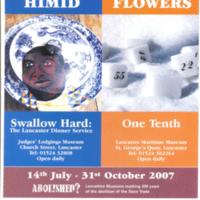
Abolished? Lancashire Museums marking 200 years of the abolition of the Slave Trade
Lancaster was the UK's fourth largest slaving port at the height of the transatlantic slave trade in the 18th century. Lancashire Museums worked with a range of partners to raise awareness of this largely hidden history - first from 2002 through STAMP (the Slave Trade Arts Memorial Project), and in 2007 through Abolished? This bicentenary project consisted of exhibitions, creative writing, radio broadcasts, and schools projects, one of which produced a Slavery Town Trail that explored some of the buildings made possible by the wealth the slave trade brought to Lancaster. At the heart of the project were commissioned installations and interventions by artists Lubaina Himid ('Swallow Hard: The Lancaster Dinner Service' at the Judge's Lodgings) and Sue Flowers ('One Tenth' at Lancaster Maritime Museum). Both were accompanied by outreach programmes and workshops with local schools. A touring exhibition was produced in partnership with Anti-Slavery International and Lancashire County Council Youth and Community, which looked at transatlantic slavery and modern day slavery. The exhibition toured throughout Lancashire.
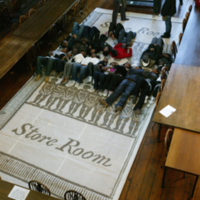
Changing Perspectives
Changing Perspectives was a community-based initiative based around the experiences of twenty-five African and Caribbean families from the North-East, to explore how their life in the UK contrasts with the lives of their ancestors. The project created a multimedia archive of cultural responses to celebrate the heritage of these families. This included oral testimonies, creative writing, photography, digital storytelling and art, emerging from a variety of community-led workshops. A series of workshops were held at Durham University Library, Archives and Special Collections (pictured), including a session aimed at children and young people, which focused on the experiences of children in the slave trade via extracts from the autobiography of Olaudah Equiano. Project outputs included a book, an interactive website, an exhibition of words and pictures of the community, an oral testimony collection, and series of documentary films. A key aim of the project was to promote community cohesion and develop cross cultural awareness and understanding.
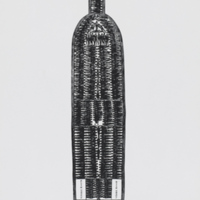
Absolut Power
This piece of art by Hank Willis Thomas is based on the Brookes slave ship image which was made famous by the British abolitionist campaign against transatlantic slavery. The artist said of the piece that “Racism is the most successful advertising campaign of all time... Africans have hundreds if not thousands of years of culture. Having all of these people packed into ships and then told they’re all the same, reducing them to a single identity—that’s absolute power.”

The Iniquity of Slavery
Durham University Library holds many archives relating to the slave trade in its Special Collections due to a connection with the family of abolitionist Granville Sharp. This is supplemented by material relating to the West Indies and the slave trade in the papers of the Prime Minister between 1830 and 1834, Charles Grey, 2nd Earl Grey. This material had already been used in a series of online resources available to download on the 4schools website. Central to their bicentenary commemorations in 2007 was a special event to recreate the image of the slave ship ‘Brookes’ using a life-size print of the middle deck and populating it with nearly 300 students from local schools. Students were also given the opportunity to learn African dance and drumming. The handling collection, print and resources produced as a result of this event are still in use for outreach work with local schools.